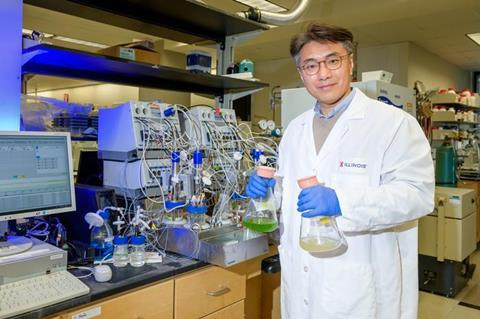Scientists have spent decades genetically modifying the bacterium Escherichia coli and other microbes to convert carbon dioxide into useful biological products. Most methods require additional carbon sources, however, adding to the cost. A new study overcomes this limitation by combining the photosynthetic finesse of a single-celled algae with the production capabilities of the bacteria E. coli.

The researchers report their results in the journal Metabolic Engineering.
READ MORE: Greener and cleaner: Yeast-green algae mix improves water treatment
READ MORE: Micromachines are powered by tiny, active microorganisms
This is not the first line of research to combine the special talents of photosynthetic organisms with other microbes. Previous studies have used cyanobacteria to take in CO2 and convert it into sugars that are then taken up by bacteria or yeast as a fuel and carbon source, said study lead Yong-Su Jin, a professor of food science and human nutrition and an affiliate of the Carl R. Woese Institute for Genomic Biology at the University of Illinois Urbana-Champaign. The new method differs from those because the microalgae used, a mutant form of Chlamydomonas reinhardtii, takes in CO2 and excretes an organic acid, glycolate. E. coli readily consumes glycolate, but many other organisms cannot, whereas sugar has universal appeal and can feed a variety of microorganisms.
“Sometimes sugars are better for the production of certain products, and sometimes the organic acid is better,” Jin said. “But if we use glycolate instead of sugar, we have less chance of contamination with outside organisms.”
Perfect partners
If left to grow by itself, the mutant C. reinhardtii will eventually produce so much glycolate that it poisons itself. But when co-cultured with E. coli, the bacteria will consume the glycolate, keeping the microalgae alive and relatively healthy.
Numerous experiments led to the design of a modular co-culture bioreactor. First, C. reinhardtii is grown alone in a chamber under conditions that are ideal for the microalgae, boosting its population density while limiting its glycolate production. In a second chamber, the microalgae and E. coli are grown together, allowing the microalgae to produce enough glycolate to feed the bacteria, supplying enough carbon for the production of useful chemicals.
“It’s kind of mutualistic system,” Jin said. “E. coli removes the glycolate, benefitting the Chlamydomonas.”
Valuable compounds
The researchers used this setup to generate two valuable compounds: lycopene, a powerful carotenoid antioxidant with numerous potential health benefits, and green fluorescent protein, which is widely used in biochemical research.
The successful production of these compounds is a proof-of-concept that the system works, Jin said.
“We can also imagine that we can use this approach to make other valuable proteins such as insulin,” he said.
The new method is most likely to be useful for expensive end products that are needed in relatively small batches, rather than for the production of high-volume, low-cost products like biofuels, Jin said.
“We can make maybe 1,000 tons or 10 tons of our product this way, but I don’t think we can make gigatons of product using this process,” he said. Creating and maintaining a bioreactor with the adequate environmental controls would be too costly for the large-scale production of biofuels.
Space potential
Jin also sees the potential for application of the technology in space travel, where astronauts will need to produce nutrients or medicines for themselves in flight.
“As long as we have sunlight and CO2 we can implement this process,” he said.
The following funders supported this research: Realizing Increased Photosynthetic Efficiency, a project at the U. of I. with partners across the U.S. funded by Gates Agricultural Innovations and the U.S. Department of Agriculture; the Foundation for Food and Agricultural Research; the Department for International Development in the U.K.; the U.S. Department of Energy, the Korea Institute for Advancement of Technology; and the Ministry of Trade, Energy and Industry in Korea.







No comments yet